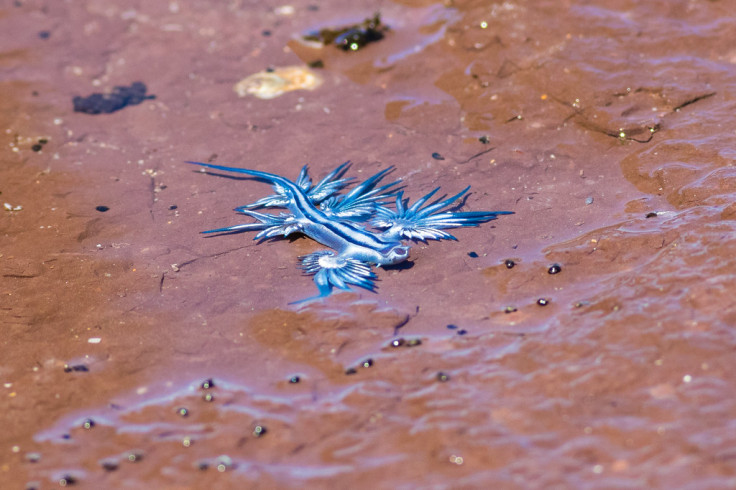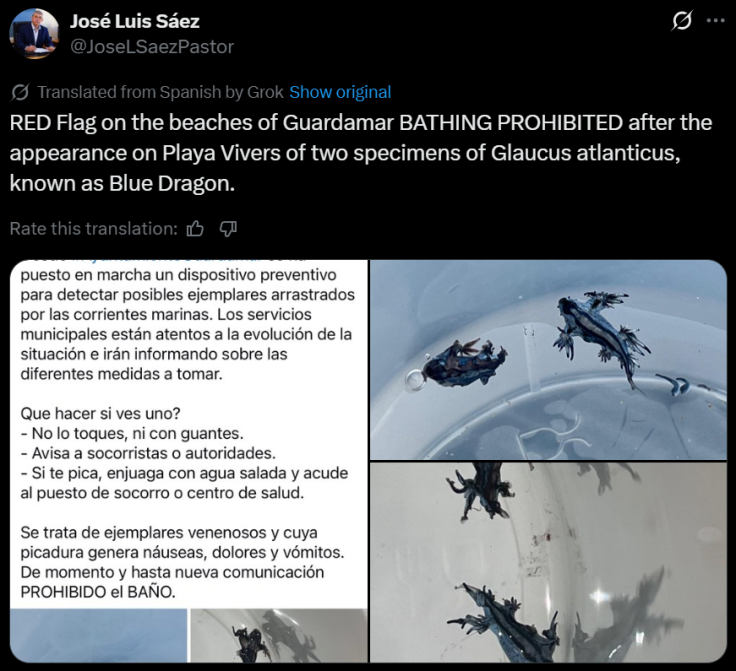Spain Closes Beach After 'Most Beautiful Killers in the Ocean' Invade — Stings Can Trigger Severe Nausea, Vomitting
Authorities raise red flags along Costa Blanca as rare and venomous Blue Dragons wash ashore, prompting urgent safety warnings and a full swimming ban

Tourists on Spain's popular Costa Blanca coastline have been banned from entering the sea after sightings of a rare and venomous marine creature known as the Blue Dragon, described by scientists as 'the most beautiful killer in the ocean.'
Authorities in Guardamar del Segura, a municipality located just north of Torrevieja, have closed a seven-mile stretch of beach following sightings of the Glaucus atlanticus, or the Blue Dragon.
The decision was announced by Mayor José Luis Sáez, who confirmed the sea ban on his official X account. 'Red flag on the beaches of Guardamar,' he wrote. 'Bathing is prohibited following the appearance on Vivers Beach of two specimens of Glaucus atlanticus, known as the Blue Dragon.'

What Are Blue Dragons?
Despite their dazzling appearance, a shimmering blend of electric blue and silver, Blue Dragons are not to be underestimated.
These tiny sea slugs, measuring just 1.5 inches, feed on venomous marine creatures such as the Portuguese Man o' War, by-the-wind sailors, and blue button jellyfish. They absorb and concentrate the stinging cells of their prey, making their sting significantly more potent.
Jace Tunnell, director of community engagement at the Harte Research Institute for Gulf of Mexico Studies, explained the heightened danger posed by Blue Dragons in an interview with the BBC. 'That's what makes them so dangerous, since they can release the stinging cells all at one time,' he said. 'It can be three times the intensity of a man-o-war due to that.'
Marine biologists warn that contact with a Blue Dragon can result in severe symptoms, including nausea, vomiting, intense pain, and, in rare cases, dangerous allergic reactions. Vulnerable individuals, such as children, those with heart or respiratory conditions, or anyone stung multiple times, may face life-threatening complications.
Climate Change and Jellyfish Surges

The Blue Dragon's arrival is part of a broader trend affecting Spanish coastlines. Rising sea temperatures, altered ocean currents, and declining predator populations have contributed to the occurrence of unpredictable jellyfish blooms across the Mediterranean and Atlantic coasts.
According to marine biologist Josep María Gili, 'The old rules no longer apply. We are seeing patterns that make prediction extremely difficult.'
This summer, jellyfish appeared earlier than expected in the Mediterranean and in greater numbers along the Atlantic coast. The Costa Blanca, in particular, has seen swarms of jellyfish-like creatures, prompting repeated warnings and beach closures.
Public Safety Measures in Place
Guardamar del Segura's town hall has launched a preventive operation to monitor ocean currents and detect further specimens. Lifeguards and municipal workers are actively patrolling the beaches, and red flags remain raised to signal the swimming ban.
Officials have issued clear guidance for beachgoers: do not touch the Blue Dragons, even with gloves, and alert lifeguards or local authorities if one is spotted. In the event of a sting, victims are advised to rinse the affected area with salt water and seek immediate medical attention.
Apps such as MedusApp are also being recommended to help tourists track jellyfish sightings before heading to the beach.
Tourists Defying the Ban
Despite the warnings, some visitors have been seen defying the bathing ban, risking both their health and potential fines. Vivers Beach, a natural stretch of coast between the Segura River and La Babilonia Beach, was reportedly full of sunbathers, although fewer people ventured into the water.
Local authorities continue to monitor the situation and have promised to update the public as conditions evolve. For now, the message is clear: admire the Blue Dragon from afar—its beauty belies a dangerous sting.
© Copyright IBTimes 2025. All rights reserved.





















